Experimental Study on Ratio Optimization of Similar Materials for Underground Mining of Shendong Coalfield: A Case Study of Shangwan Coal Mine
Abstract
1. Introduction
2. Similar Material Proportioning Orthogonal Test Scheme
3. Specimen Production
4. Analysis of Experimental Results
5. Sensitivity and Multiple Regression Analysis
6. Discussion
7. Conclusions
- Our research has demonstrated the effectiveness of the polynomial model in fitting mining engineering data for material analysis. Through increasing the polynomial degree, we were able to improve the accuracy of the model while maintaining an acceptable error margin. Our findings indicate that the sand to cement ratio, paste to ash ratio, and maintenance days are primary variables influencing material behavior, and that our methodology can guide the creation of physical models of Shendong coalfield. While we acknowledge that other factors may play a role in this process, our study highlights the importance of these variables in material analysis.
- Sensitivity analyses conducted using the methods of polar difference analysis and variance analysis revealed that the sand to cement ratio, paste to ash ratio, and maintenance days had the greatest influence on density, while the paste to ash ratio, maintenance days, and sand to cement ratio had the greatest influence on strength. Single-factor analysis indicated that sand to cement ratio was negatively correlated with both strength and density, while paste to ash ratio was positively correlated with both. Maintenance days were found to be positively correlated with strength and negatively correlated with density. Based on our findings, we suggest that the reasonable range of maintenance days is between 5–10 days. Furthermore, we derived a higher order fitting equation for the effect of sand to cement ratio and paste to ash ratio on strength, determining that the third-order fitting equation could be used to guide the proportion selection of physical simulation experiments in the Shendong coalfield.
- Using the similar material ratio presented in our study, we constructed a physical model of Shangwan coal mine. From this model, we obtained valuable insights into the periodic weighting distance and stress nephogram of the coal seam. Our research contributes to the advancement of mining engineering by providing insights into material analysis and physical modeling techniques and offers guidance for future research and development in this field.
Author Contributions
Funding
Data Availability Statement
Conflicts of Interest
References
- Das, D.; Das, S.K.; Parhi, P.K.; Dan, A.K.; Mishra, S.; Misra, P.K. Green strategies in formulating, stabilizing and pipeline transportation of coal water slurry in the framework of water-energy nexus: A state of the art review. Energy Nexus 2021, 4, 100025. [Google Scholar] [CrossRef]
- Kidd, S. Coal—Is it a competitor to new nuclear? Nucl. Eng. Int. 2009, 665, 12–13. [Google Scholar]
- Ray, S.K.; Khan, A.M.; Mohalik, N.K.; Mishra, D.; Mandal, S.; Pandey, J.K. Review of preventive and constructive measures for coal mine explosions: An Indian perspective. Int. J. Min. Sci. Technol. 2022, 32, 471–485. [Google Scholar] [CrossRef]
- Hosseini, N. Evaluation of the rockburst potential in longwall coal mining using passive seismic velocity tomography and image subtraction technique. J. Seismol. 2017, 21, 1101–1110. [Google Scholar] [CrossRef]
- Martirosyan, A.V.; Ilyushin, Y.V. The Development of the Toxic and Flammable Gases Concentration Monitoring System for Coalmines. Energies 2022, 15, 8917. [Google Scholar] [CrossRef]
- Fuławka, K.; Pytel, W.; Mertuszka, P. The effect of selected rockburst prevention measures on seismic activity—Case study from the Rudna copper mine. J. Sustain. Min. 2018, 17, 1–10. [Google Scholar] [CrossRef]
- Khademian, Z.; Ugur, O. Computational framework for simulating rock burst in shear and compression. Int. J. Rock Mech. Min. Sci. 2018, 110, 279–290. [Google Scholar] [CrossRef]
- He, C.; Lu, W.; Zha, W.; Wang, F. A geomechanical method for predicting the height of a water-flowing fractured zone in a layered overburden of longwall coal mining. Int. J. Rock Mech. Min. Sci. 2021, 143, 104798. [Google Scholar] [CrossRef]
- Wang, J.C. Theory and Technology of Thick Seam Mining; Metallurgy Industry Press: Beijing, China, 2019; pp. 1–10. [Google Scholar]
- Wang, J.C.; Wang, Z.H.; Tang, Y.S.; Li, M.; Chang, K.L.; Gong, H.; Xu, G.L. Experimental study on mining-induced dynamic impact effect of main roofs in deeply buried thick coal seams with weakly consolidated thin bed rock. Chin. J. Rock Mech. Eng. 2021, 40, 2377–2391. [Google Scholar]
- Yang, S.L.; Wang, J.C.; Yang, J.H. Physical analog simulation analysis and its mechanical explanation on dynamic load impact. J. China Coal Soc. 2017, 42, 335–343. [Google Scholar]
- Feng, X.W.; Wang, M.K.; Xue, F.; Zhao, T.Y.; Song, W.X.; Wei, Q.; Zhu, Y.C. Investigation on mine physical simulation model embedded with iso-strength scaled 3D printed support system. J. China Univ. Min. Technol. 2022, 51, 232–243 + 256. [Google Scholar]
- Zhao, X.Y.; Zhang, X.Y.; Han, Z.H.; Han, G. Simulation study on spatial structure evolution characteristics of coal seam mining with hard overbburden rock. Min. Res. Dev. 2022, 42, 6–10. [Google Scholar]
- Zhang, X.Y.; Xie, G.X. 3D analog simulation of pillar width effect of stress and caving height of overlying strata. Coal Min. Technol. 2010, 15, 14–17 + 114. [Google Scholar]
- Wen, Z.J.; Jiang, P.F.; Jing, S.L.; Cao, Z.G.; Guang, Y.T. Development and verification of simulation testing system for floor seepage in coal mine underground reservoir. J. China Coal Soc. 2021, 46, 1487–1497. [Google Scholar]
- Chai, J.; Liu, Y.L.; Yuan, Q.; Zhang, D.D.; Do, W.G.; Han, Z.C.; Ma, Z.; Lei, W.L. Theory−technology and application of optical fiber sensing on deformation and failure of mine surrounding rock. Coal Sci. Technol. 2021, 49, 208–217. [Google Scholar]
- Chai, J.; Do, W.G.; Lei, W.L.; Peng, Y.B. Water-resisting key strata stability detected by optic fiber sensing in shallow-buried coal seam. J. Min. Saf. Eng. 2020, 37, 731–740. [Google Scholar]
- Qin, G.P.; Cao, J.; Wang, C.; Wu, S.; Zhai, M.H. Characteristics of Stratum Structure and Fracture Evolution in Stratified Mining of Shallow Buried High-Gas-Thick Coal Seam by Similarity Simulation. Geofluids 2021, 2021, 5555451. [Google Scholar]
- Ye, Q.; Wang, G.; Jia, Z.Z.; Zheng, C.S.; Wang, W.J. Similarity simulation of mining-crack-evolution characteristics of overburden strata in deep coal mining with large dip. J. Pet. Sci. Eng. 2018, 165, 477–487. [Google Scholar] [CrossRef]
- Liu, Y.L.; Zhou, W.Z.; Guo, B.; Ma, Q.; Xiao, H.L. Study on marl similar materials in similar simulation test. Chin. J. Rock Mech. Eng. 2020, 39, 2795–2803. [Google Scholar]
- Xiao, J.; Wu, J.J.; Shao, Y.W.; Yang, H. Similar simulation study on mine pressure behavior law of 8.5 m high mining face. Coal Sci. Technol. 2019, 47, 106–111. [Google Scholar]
- Ma, J.H.; Hou, C.; Hou, J.T. Numerical and Similarity Simulation Study on the Protection Effect of Composite Protective Layer Mining with Gently Inclined Thick Coal Seam. Shock Vib. 2021, 2021, 6679199. [Google Scholar] [CrossRef]
- Gao, X.C.; Wu, Y.P.; Cao, P.P.; Wang, H.W.; Yin, J.H. Overlying strata movement property of fully mechanized caving angle-varied workface in steep dipping seam. J. Min. Saf. Eng. 2016, 33, 381–386. [Google Scholar]
- Shi, J.J.; Feng, J.C. Research on the Regular of Underground Pressure by Similarity Simulation. Geotech. Geol. Eng. 2021, 39, 5359–5364. [Google Scholar]
- Fu, J.H.; Sun, H.T.; Wen, G.C.; Li, R.F. Three-Dimensional Physical Similarity Simulation of the Deformation and Failure of a Gas Extraction Surface Well in a Mining Area. Adv. Civ. Eng. 2020, 2020, 8834199. [Google Scholar] [CrossRef]
- Li, S.C.; Zhou, Y.L.; Li, P. Development and application of a new similar material for underground engineering fluid-solid coupling model test. Chin. J. Rock Mech. Eng. 2012, 31, 1128–1137. [Google Scholar]
- Li, S.C.; Feng, X.D.; Li, S.C.; Li, L.P.; Li, G.Y. Research and development of a new similar material for solid-fluid coupling and its application. Chin. J. Rock Mech. Eng. 2010, 29, 281–288. [Google Scholar]
- Zhang, Q.Y.; Xiang, W.; Zhang, Y.; Wang, C.; Liu, C.C. Development and application of ultra high pressure 3D loading model test system with intelligent numerical control function. Chin. J. Rock Mech. Eng. 2016, 35, 1628–1637. [Google Scholar]
- Sidorenko, A.A.; Ivanov, V.V.; Sidorenko, S.A. Numerical simulation of rock massif stress state at normal fault at underground longwall coal mining. Int. J. Civ. Eng. Technol. 2018, 10, 844–851. [Google Scholar]
- Bagarello, V.; Ferro, V.; Keesstra, S.; Comino, J.R.; Pulido, M.; Cerdà, A. Testing simple scaling in soil erosion processes at plot scale. Catena 2018, 167, 171–180. [Google Scholar] [CrossRef]
- Gomathi, K.A.; Rajagopal, A.; Reddy, K.S.S.; Ramakrishna, B. Plasticity based material model for concrete subjected to dynamic loadings. Int. J. Impact Eng. 2020, 142, 103581. [Google Scholar] [CrossRef]
- Moussaei, N.; Sharifzadeh, M.; Sahriar, K.; Sahriar, K.; Khosravi, M.H. A new classification of failure mechanisms at tunnels in stratified rock masses through physical and numerical modeling. Tunn. Undergr. Space Technol. 2019, 91, 103017. [Google Scholar] [CrossRef]
- Shen, Z.; Huang, X.M. Test study on the Solidified Fly Ash. J. Highw. Transp. Res. Dev. 2007, 1, 26–29. [Google Scholar]
- Liang, X.Z.; Wang, H. Experimental Research on Roadway Filling with Skeleton Type Based on Construction Waste. Met. Mine 2011, 40, 62–64. [Google Scholar]
- Berredjem, T.; Benidir, M. Bearing faults diagnosis using fuzzy expert system relying on an Improved Range Overlaps and Similarity method. Expert Syst. Appl. 2018, 108, 134–142. [Google Scholar] [CrossRef]
- Galdames, F.J.; Perez, C.A.; Estévez, P.A.; Adams, M. Rock lithological classification by hyperspectral, range 3D and color images. Chemom. Intell. Lab. Syst. 2019, 189, 138–148. [Google Scholar] [CrossRef]
- Zhang, X.Y.; Luo, L.; Xu, L.F.; Zhao, M. Research on quantitative determination method of similar materials ratio. Saf. Coal Mines 2019, 50, 45–48 + 53. [Google Scholar]
- Liu, Y.; Wang, H.; Qi, Q.; Wang, A.H.; Zhao, Y.X. Dynamic evolution law of overburden rock in shallow-buried super-high fully mechanized working face and determination of support strength. Shock Vib. 2021, 2021, 7649459. [Google Scholar] [CrossRef]
- Zeng, X.T.; Wang, N.; Jiang, C.; Zhang, Y.Y.; Cheng, G. The three-dimensional similar simulation of stress regular pattern of roof of large mining height. In Advanced Materials Research; Trans Tech Publications Ltd.: Baech, Switzerland, 2014; Volume 945, pp. 1190–1195. [Google Scholar]
- Bai, E.H.; Guo, W.B.; Zhang, D.; Yi, T.; Guo, M.J.; Zhao, G.B. Using the magnetotelluric method for detecting aquifer failure characteristics under high-intensity mining of thick coal seams. Energies 2019, 12, 4397. [Google Scholar] [CrossRef]
- Jia, S.Y.; Hu, T.F.; Lu, G.Z. Application of algorithm for simulation of overburden movement and analysis of ground pressure law in 8.8 m high mining face in Shangwan Coal Mine. Coal Sci. Technol. 2021, 49 (Suppl. S1), 1–6. [Google Scholar]



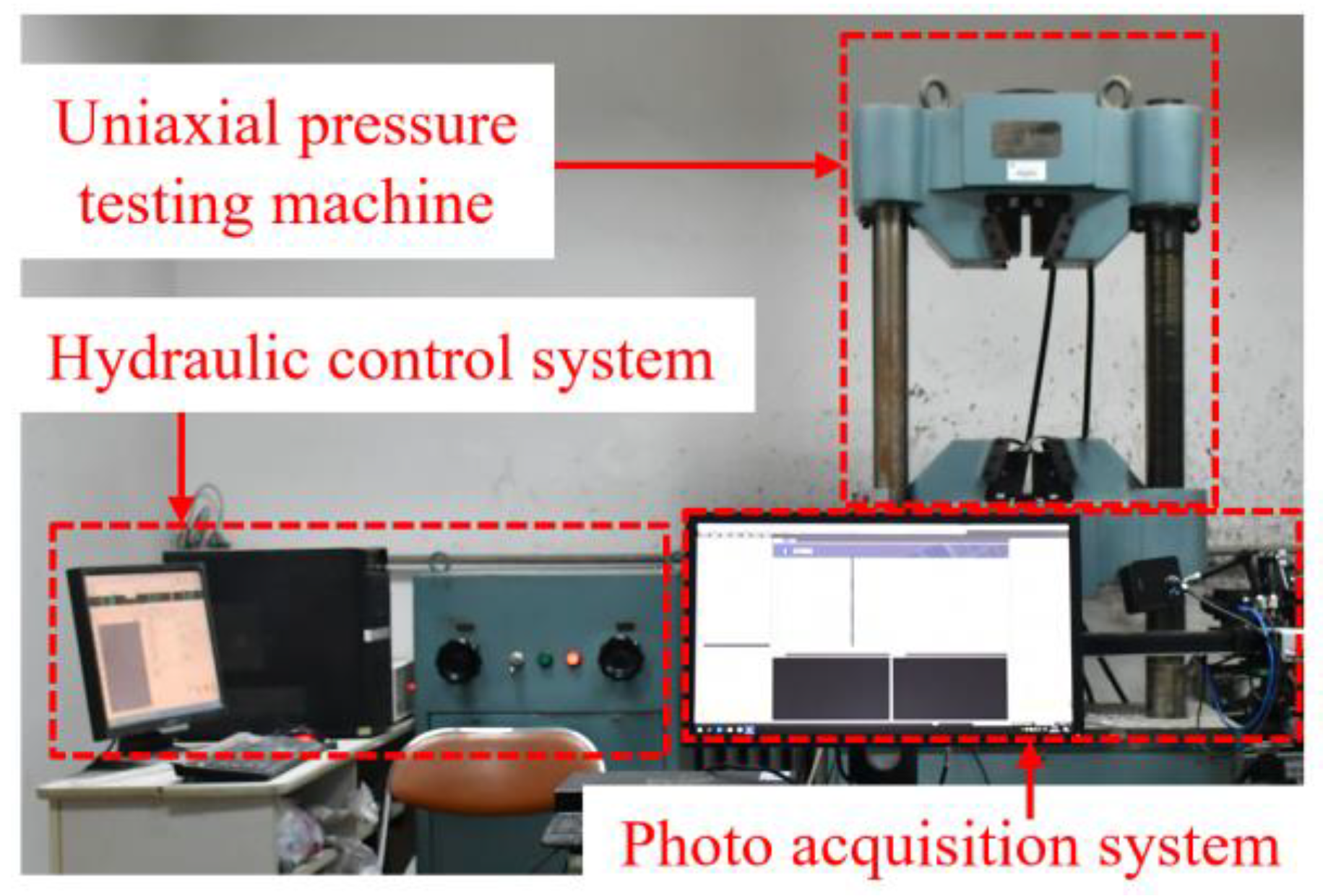
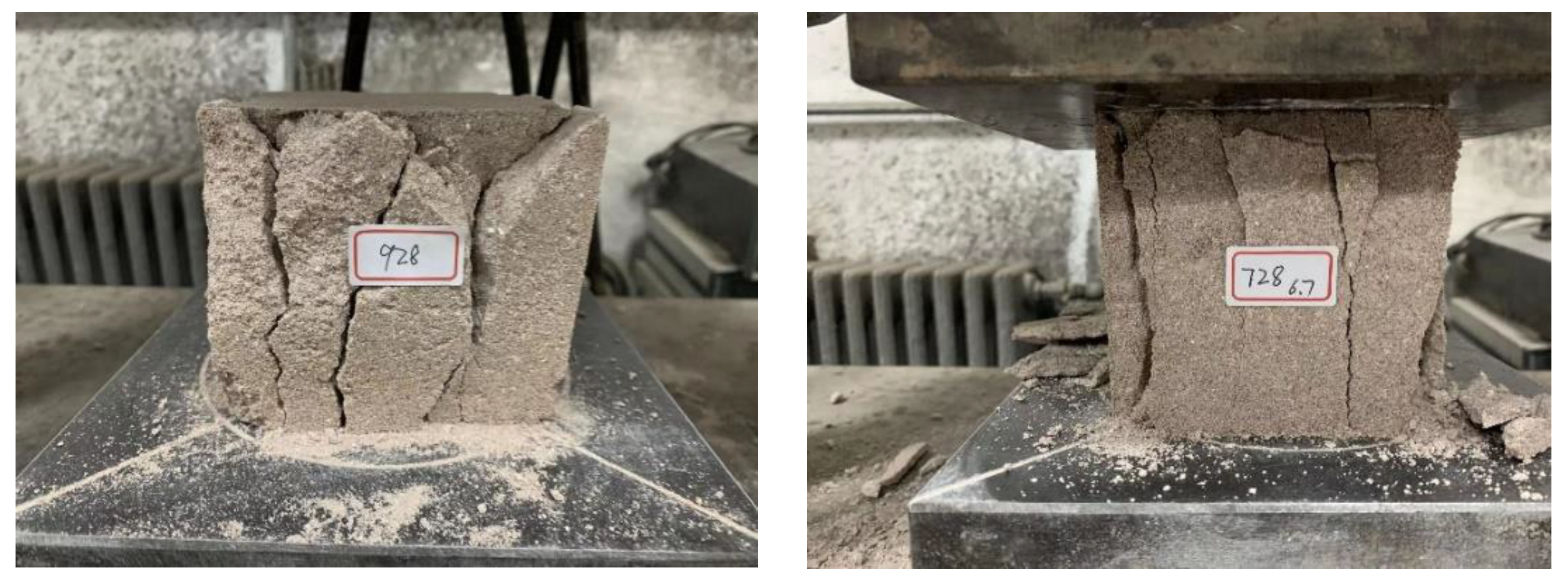
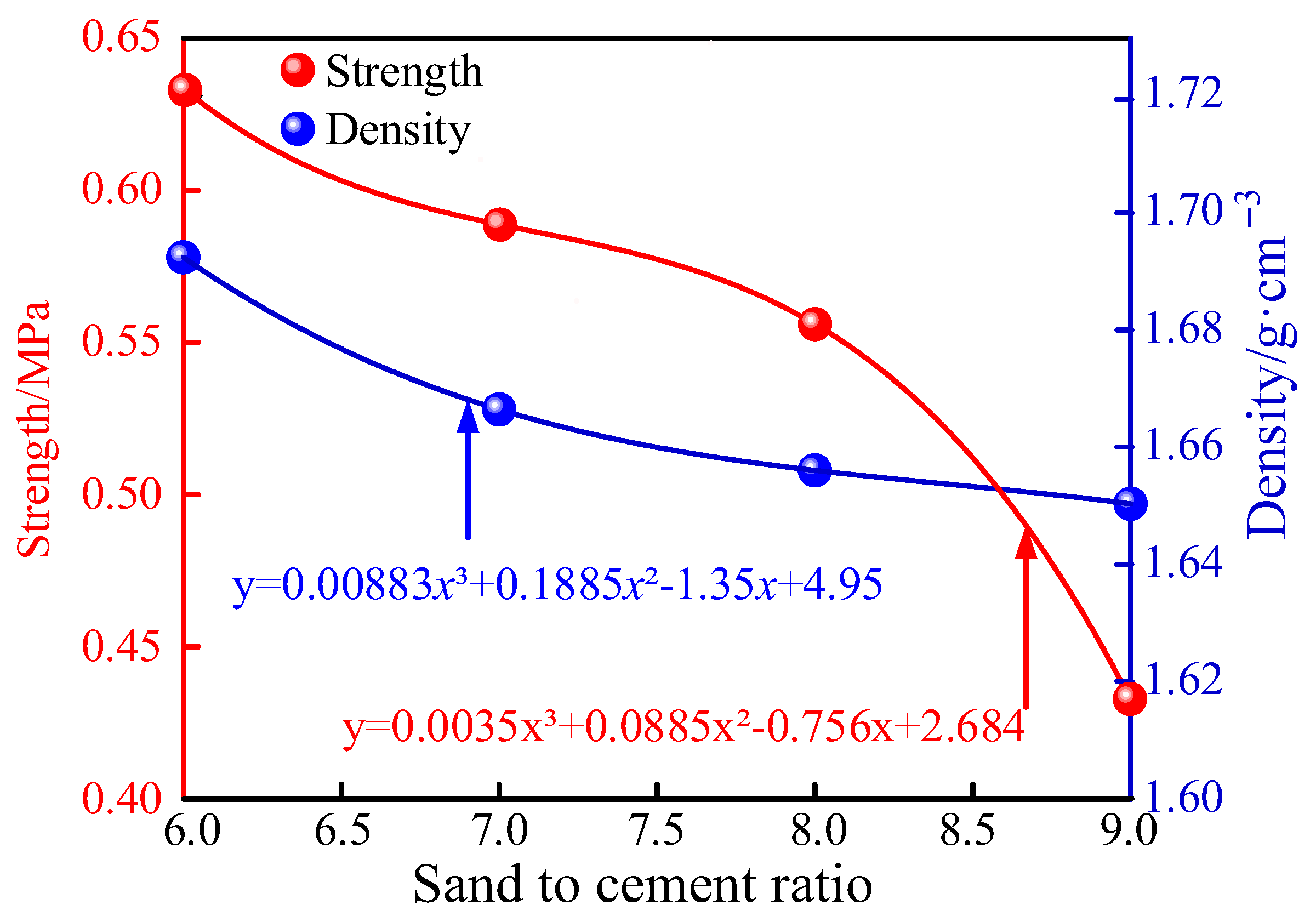
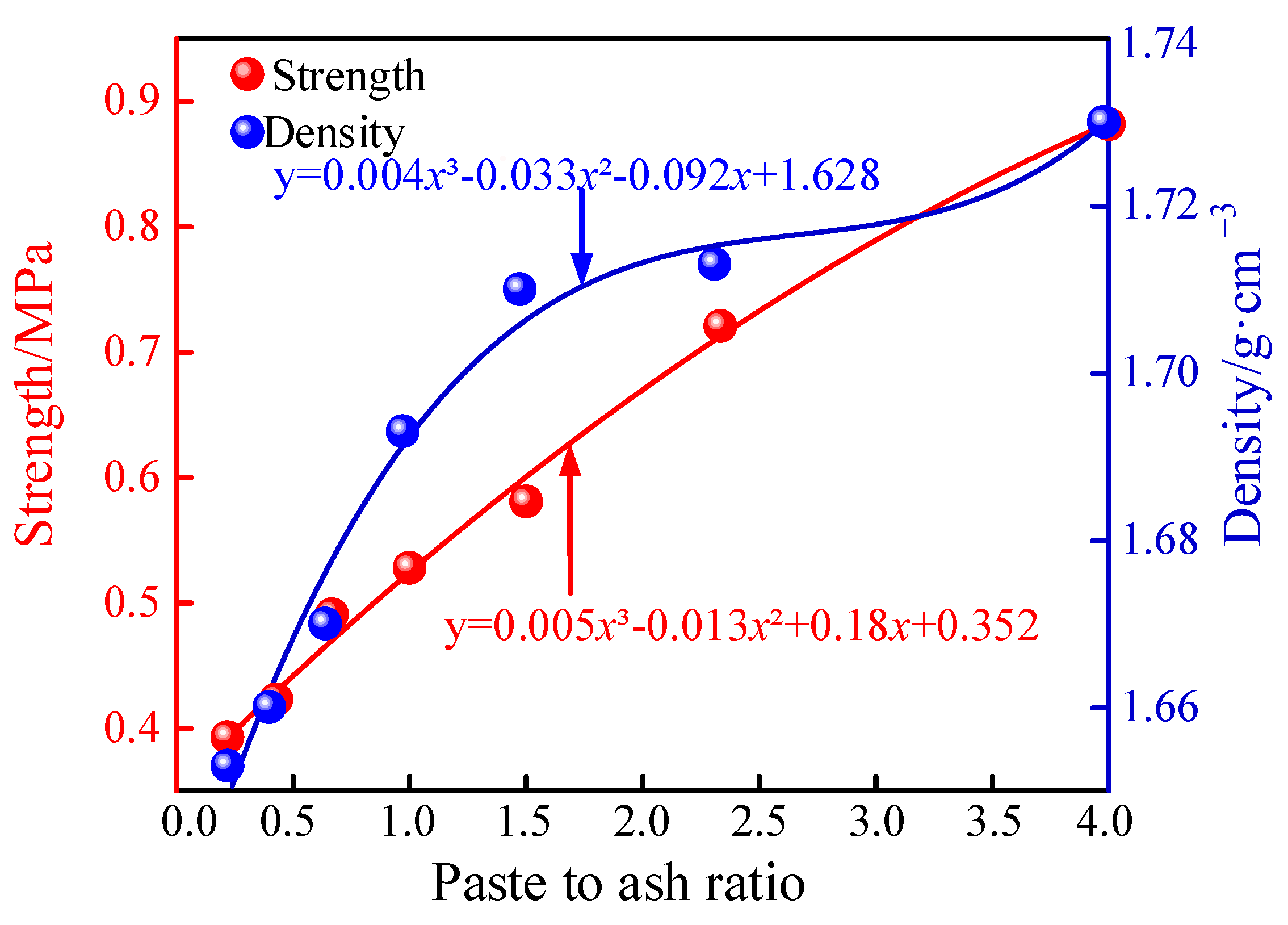

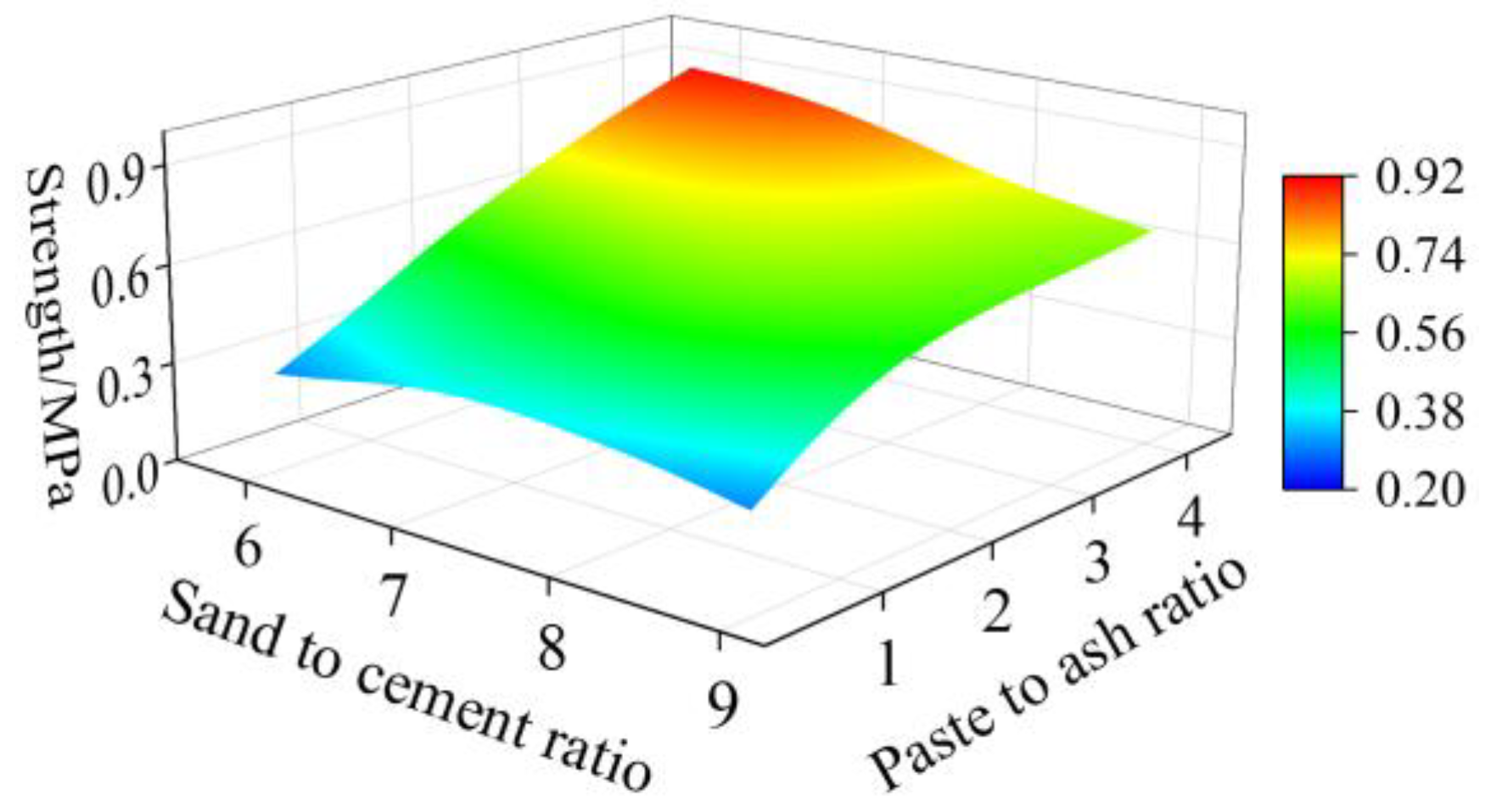


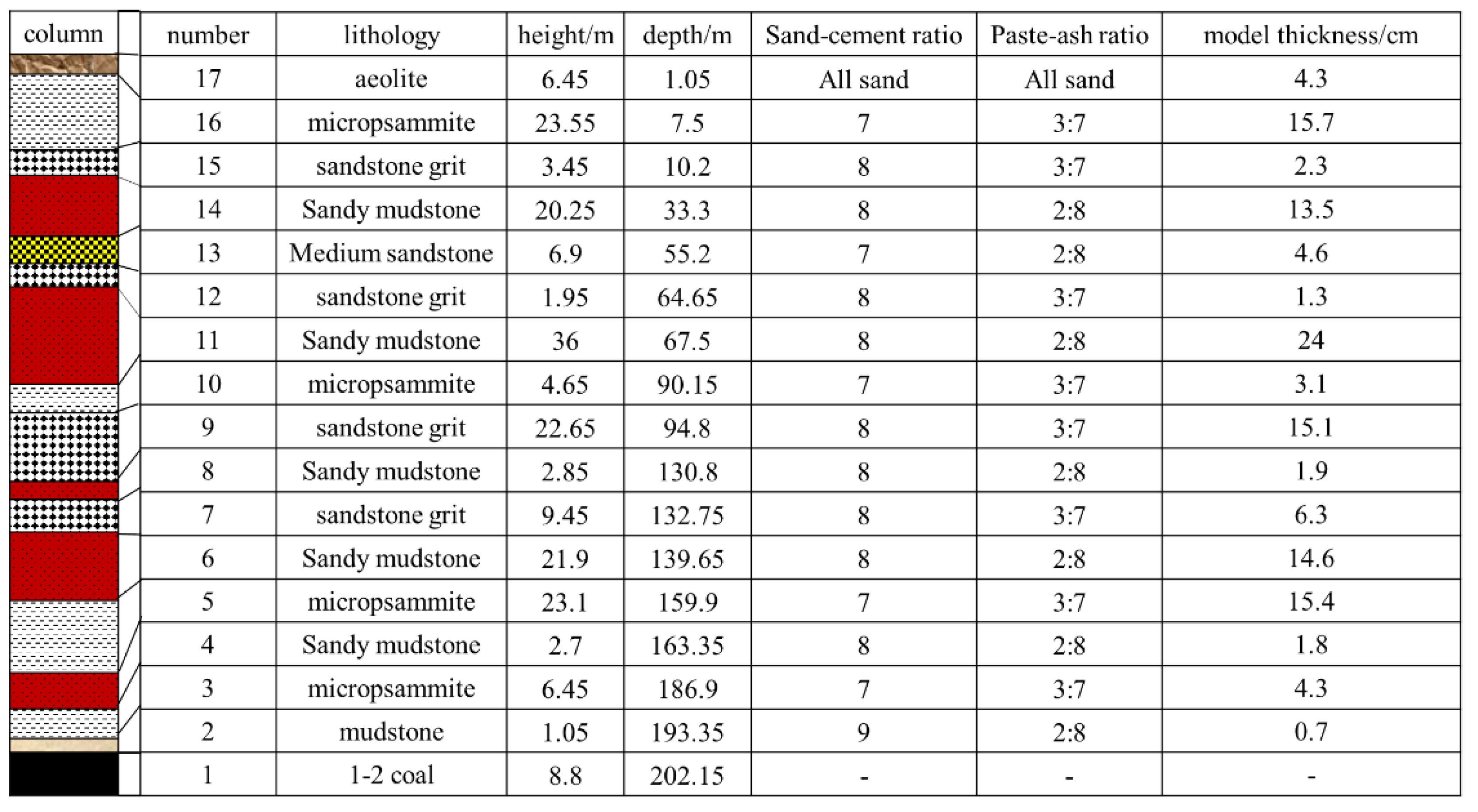
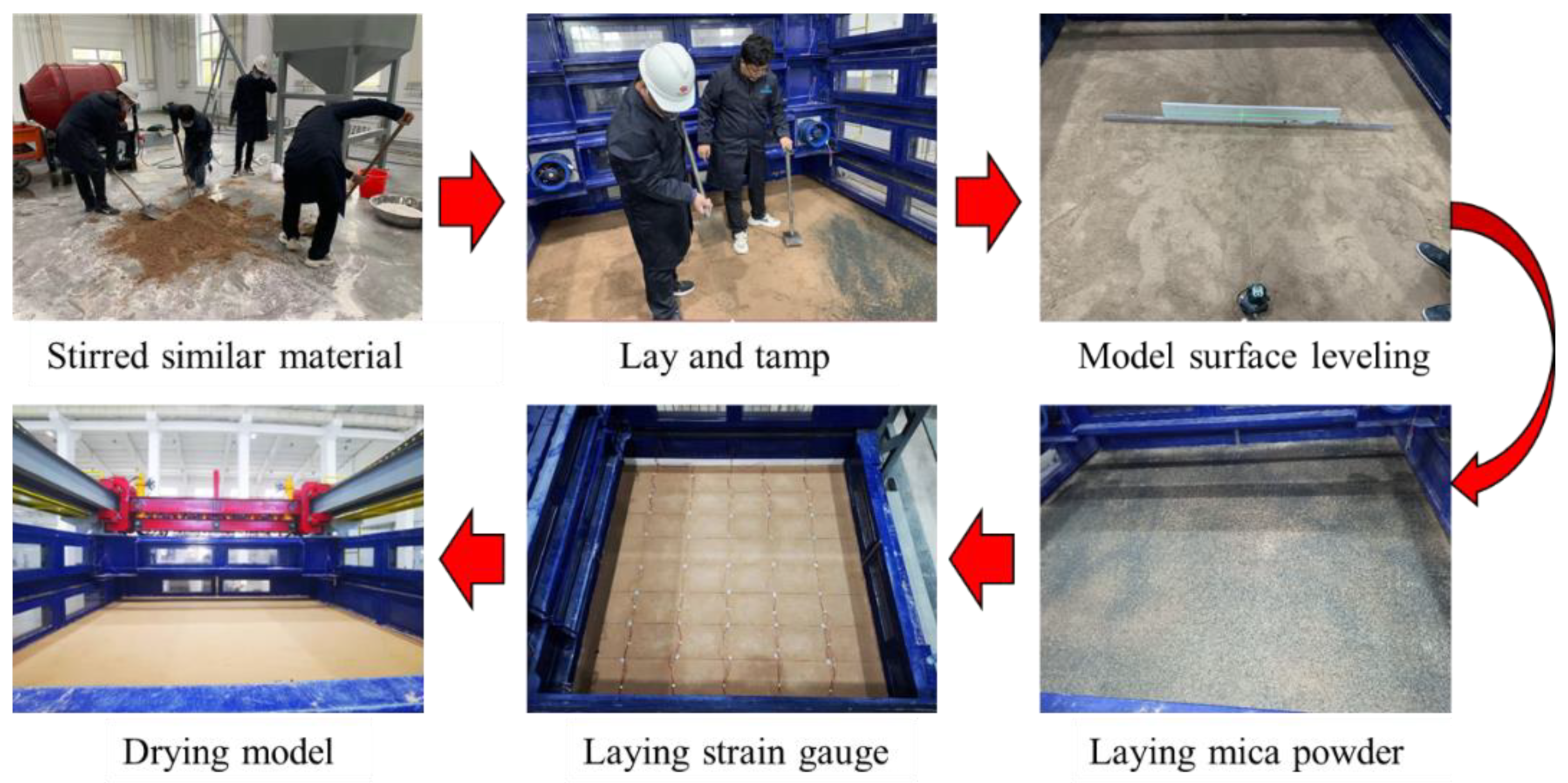

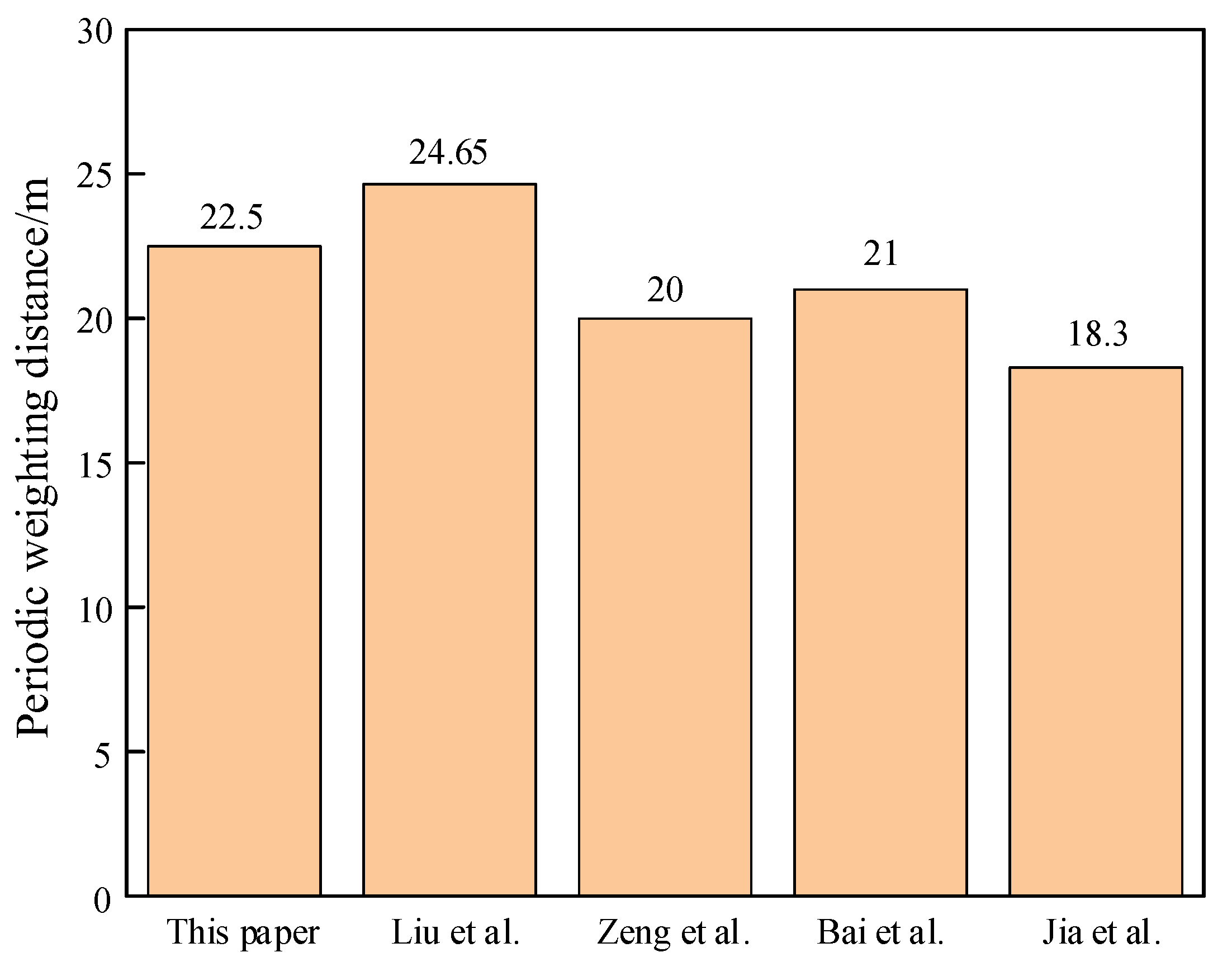
| Number of Horizontal Groups | Sand to Cement Ratio | Paste to Ash Ratio | Maintenance Days |
|---|---|---|---|
| I | 6:1 | 2:8 | 2 |
| II | 7:1 | 3:7 | 5 |
| III | 8:1 | 4:6 | 7 |
| IV | 9:1 | 5:5 | 9 |
| V | - | 6:4 | 14 |
| VI | - | 7:3 | - |
| VII | - | 8:2 | - |
| Parameter | Value |
|---|---|
| Displacement range | 150 mm |
| Displacement accuracy | ±1% |
| Displacement resolution | 0.001 mm |
| Axial force range | 600 kN |
| Axial force accuracy | ±1% |
| Axial force resolution | 0.01 kN |
| Test | Sand to Cement Ratio | Paste to Ash Ratio | Maintenance Time | Density/ g·cm−3 | Compressive Strength/MPa | Elastic Modulus/ MPa |
|---|---|---|---|---|---|---|
| Number of Horizontal Groups | ||||||
| 1 | IV | VII | III | 1.67 | 0.644 | 358.53 |
| 2 | IV | VI | III | 1.69 | 0.602 | 329.29 |
| 3 | IV | V | III | 1.69 | 0.567 | 305.75 |
| 4 | IV | IV | III | 1.73 | 0.497 | 273.98 |
| 5 | IV | III | III | 1.75 | 0.455 | 256.73 |
| 6 | IV | II | III | 1.74 | 0.336 | 237.18 |
| 7 | IV | I | III | 1.78 | 0.203 | 208.07 |
| 8 | III | VII | III | 1.65 | 0.693 | 384.93 |
| 9 | III | VI | III | 1.67 | 0.665 | 365.03 |
| 10 | III | V | III | 1.69 | 0.571 | 341.15 |
| 11 | III | IV | III | 1.71 | 0.509 | 319.32 |
| 12 | III | III | III | 1.71 | 0.483 | 289.58 |
| 13 | III | II | III | 1.72 | 0.399 | 258.77 |
| 14 | III | I | III | 1.74 | 0.327 | 235.14 |
| 15 | II | VI | III | 1.65 | 0.882 | 412.73 |
| 16 | II | V | III | 1.64 | 0.721 | 389.06 |
| 17 | II | IV | III | 1.65 | 0.581 | 357.74 |
| 18 | II | III | III | 1.68 | 0.528 | 318.96 |
| 19 | II | II | III | 1.72 | 0.491 | 284.86 |
| 20 | II | I | III | 1.71 | 0.423 | 255.69 |
| 21 | II | VII | III | 1.72 | 0.392 | 241.46 |
| 22 | I | VI | III | 1.64 | 0.917 | 583.74 |
| 23 | I | V | III | 1.64 | 0.772 | 548.36 |
| 24 | I | IV | III | 1.65 | 0.688 | 501.83 |
| 25 | I | III | III | 1.65 | 0.578 | 472.07 |
| 26 | I | II | III | 1.66 | 0.457 | 452.49 |
| 27 | I | I | III | 1.68 | 0.422 | 438.39 |
| 28 | I | VI | III | 1.68 | 0.387 | 395.81 |
| 29 | IV | VII | I | 1.71 | 0.375 | 285.03 |
| 30 | IV | VII | II | 1.68 | 0.621 | 321.83 |
| 31 | IV | VII | III | 1.67 | 0.644 | 358.53 |
| 32 | IV | VII | IV | 1.67 | 0.653 | 392.57 |
| 33 | IV | VII | V | 1.65 | 0.712 | 463.02 |
| Horizontal Groups | Density Mean Value/g·cm−3 | Polar Difference | Variance | |||||||
|---|---|---|---|---|---|---|---|---|---|---|
| Influencing Factors | I | II | III | IV | V | VI | VII | |||
| Sand to cement ratio | 1.617 | 1.681 | 1.698 | 1.721 | - | - | - | 0.104 | 0.00149 | |
| Paste to ash ratio | 1.730 | 1.713 | 1.710 | 1.693 | 1.670 | 1.660 | 1.653 | 0.077 | 0.00074 | |
| Maintenance days | 1.710 | 1.680 | 1.670 | 1.670 | 1.650 | - | - | 0.060 | 0.00038 | |
| Horizontal Groups | Uniaxial Compressive Strength/MPa | Polar Difference | Variance | |||||||
|---|---|---|---|---|---|---|---|---|---|---|
| Influencing Factors | I | II | III | IV | V | VI | VII | |||
| Sand to cement ratio | 0.603 | 0.574 | 0.5467 | 0.472 | - | - | - | 0.131 | 0.00237 | |
| Paste to ash ratio | 0.327 | 0.395 | 0.472 | 0.553 | 0.622 | 0.690 | 0.784 | 0.457 | 0.02277 | |
| Maintenance days | 0.375 | 0.621 | 0.644 | 0.653 | 0.712 | - | - | 0.337 | 0.01342 | |
| Horizontal Groups | Elastic Modulus Mean Value/MPa | Polar Difference | Variance | |||||||
|---|---|---|---|---|---|---|---|---|---|---|
| Influencing Factors | I | II | III | IV | V | VI | VII | |||
| Sand to cement ratio | 484.67 | 322.93 | 313.42 | 281.36 | - | - | - | 203.31 | 203.31 | |
| Paste to ash ratio | 270.12 | 297.51 | 320.92 | 346.08 | 376.62 | 407.94 | 434.98 | 164.86 | 164.86 | |
| Maintenance days | 285.03 | 321.83 | 358.53 | 392.57 | 463.02 | - | - | 177.99 | 177.99 | |
Disclaimer/Publisher’s Note: The statements, opinions and data contained in all publications are solely those of the individual author(s) and contributor(s) and not of MDPI and/or the editor(s). MDPI and/or the editor(s) disclaim responsibility for any injury to people or property resulting from any ideas, methods, instructions or products referred to in the content. |
© 2023 by the authors. Licensee MDPI, Basel, Switzerland. This article is an open access article distributed under the terms and conditions of the Creative Commons Attribution (CC BY) license (https://creativecommons.org/licenses/by/4.0/).
Share and Cite
Yang, Y.; Yue, H.; Zhao, Y.; Zhang, S.; Zhang, J.; Wang, Z.; Yang, W. Experimental Study on Ratio Optimization of Similar Materials for Underground Mining of Shendong Coalfield: A Case Study of Shangwan Coal Mine. Processes 2023, 11, 1352. https://doi.org/10.3390/pr11051352
Yang Y, Yue H, Zhao Y, Zhang S, Zhang J, Wang Z, Yang W. Experimental Study on Ratio Optimization of Similar Materials for Underground Mining of Shendong Coalfield: A Case Study of Shangwan Coal Mine. Processes. 2023; 11(5):1352. https://doi.org/10.3390/pr11051352
Chicago/Turabian StyleYang, Yingming, Hao Yue, Yongqiang Zhao, Shen Zhang, Jian Zhang, Zhaohui Wang, and Wenqiang Yang. 2023. "Experimental Study on Ratio Optimization of Similar Materials for Underground Mining of Shendong Coalfield: A Case Study of Shangwan Coal Mine" Processes 11, no. 5: 1352. https://doi.org/10.3390/pr11051352
APA StyleYang, Y., Yue, H., Zhao, Y., Zhang, S., Zhang, J., Wang, Z., & Yang, W. (2023). Experimental Study on Ratio Optimization of Similar Materials for Underground Mining of Shendong Coalfield: A Case Study of Shangwan Coal Mine. Processes, 11(5), 1352. https://doi.org/10.3390/pr11051352







